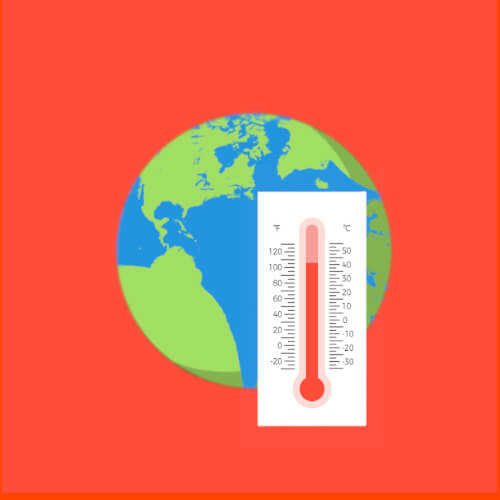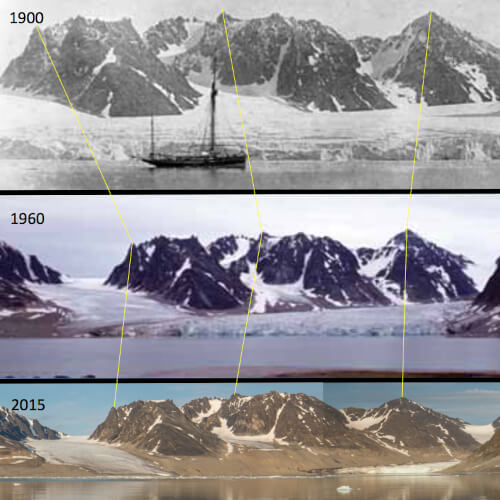



Climate change describes a change in the typical weather for a region—such as high and low temperatures and amount of rainfall—over a long period of time. Scientists have observed that, overall, the Earth is warming. This rise in global temperature is sometimes called global warming.
Some of the gases in Earth’s atmosphere trap heat from the Sun—like the glass roof and walls of a greenhouse. This is called the greenhouse effect, and it keeps Earth warm enough for us to live on. But human activities, such as the destruction of forests and burning fossil fuels, create extra greenhouse gases. This traps even more of the Sun’s heat, leading to an Earth that is warmer than natural.
Carbon is the element with atomic number 6 on the periodic table. It's an incredibly special element that's needed to form the molecules found in every single living thing on Earth, from the tiniest bacteria, to all plants and animals.
As living things die, they eventually get buried in the ground. After enough years, these underground remains get compacted, or squished, and can turn into fossil fuels, such as coal and oil. When we burn those fuels, the carbon that was in the ground goes into the air as a gas called carbon dioxide (CO2). Plants and trees can absorb some of this extra carbon dioxide, but a lot of it stays in the atmosphere as a greenhouse gas that warms up the planet.
Over millions of years, Earth's climate has warmed up and cooled down many times. In the past, Earth often warmed up when the Sun was very active. But nowadays, we can carefully measure the Sun’s activity. We know Earth is warming now, even when the Sun is less active. Today, the planet is warming much faster than it has over human history.
We all have the power to make a positive impact against climate change. We can start by conserving energy and resources, and reducing our carbon footprints. At home and school we can make special effort to turn off lights, unplug electronics, and reduce water usage. Additionally, we can support renewable energy by encouraging our families, friends, and those around us to switch to energy-efficient light bulbs and appliances, and by advocating for clean energy sources like solar and wind power.
We can also reduce the amount of waste we make by consuming less and recycling and reusing items whenever possible. We can also try our best to stop using disposable products and products that quickly end up in the trash. By raising awareness and educating others about the importance of climate change, we can inspire action in their communities and become champions for a more sustainable future.
Through photosynthesis, trees take in carbon dioxide (CO2) from the air and turn it into oxygen (O2). Trees also act like natural carbon storage, holding carbon in their trunks, branches, leaves, and roots. This can greatly reduce greenhouse gases and lower the impact of human activities on the environment.
Coral reefs are vibrant communities that provide homes for an enormous diversity of marine life. They offer food and protection to many different fish, turtles, and other sea creatures. However, when corals undergo stress, they release the algae that live inside of them. In turn, the corals lose their bright colors, weaken, and eventually die. This process is called coral bleaching, and is often caused by warming water and pollution.
Adélie penguins, for example, rely on krill as their main food source. As temperatures rise, sea ice, where krill thrive, is melting earlier and forming later. This shortened hunting season gives Adélie penguins less time to find food, potentially leading to food shortages for them and their chicks.
In addition, penguins need sea ice to find mates and raise their young. Emperor penguins, the largest penguin species, need thick sea ice to build nests and protect their eggs from harsh winds. Unfortunately, with warmer temperatures, the sea ice is melting, becoming thinner and less stable. This instability puts the survival of emperor penguin chicks at risk as their nests can collapse or be washed away.
One such glacier is the Greenland Ice Sheet, a massive expanse of ice covering most of Greenland. Over the past twenty years, it has been losing ice at a rate of approximately 270 trillion kg (595 trillion lbs) per year. Climate scientists warn that the melting of the Greenland Sheet is the single largest reason for rising sea levels.
Another significant glacier facing dramatic melt is the Pine Island Glacier in Antarctica. This icy giant is among the fastest-changing glaciers on the planet. Since the 1990s, it has retreated by over 50 km (31 mi) and is thinning at a rate of about 0.76 m (2.5 ft) per year. In just one decade, this could lead to a loss of 7.6 m (25 ft) of ice.